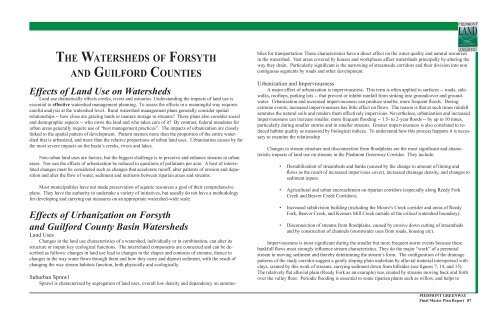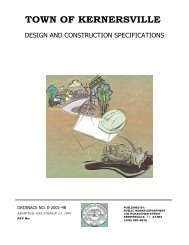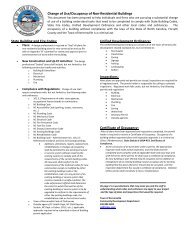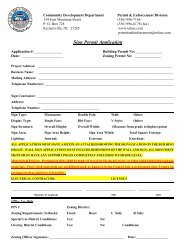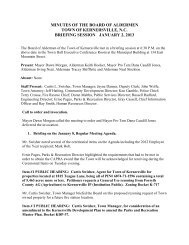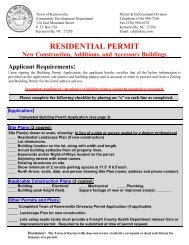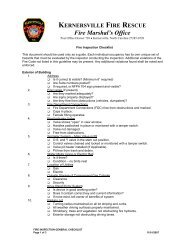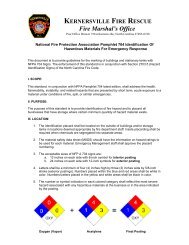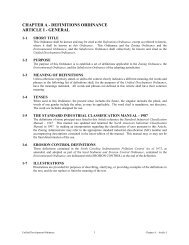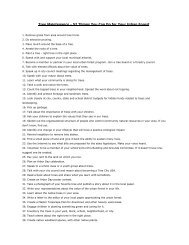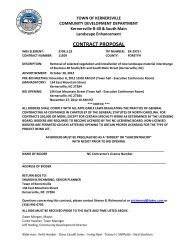Piedmont Greenway Master Plan - Town of Kernersville
Piedmont Greenway Master Plan - Town of Kernersville
Piedmont Greenway Master Plan - Town of Kernersville
- No tags were found...
You also want an ePaper? Increase the reach of your titles
YUMPU automatically turns print PDFs into web optimized ePapers that Google loves.
THE WATERSHEDS OF FORSYTH<br />
AND GUILFORD COUNTIES<br />
Effects <strong>of</strong> Land Use on Watersheds<br />
Land use dramatically effects creeks, rivers and estuaries. Understanding the impacts <strong>of</strong> land use is<br />
essential to effective watershed management planning. To assess the effects in a meaningful way requires<br />
careful analysis at the watershed level. Rural watershed management plans generally consider spatial<br />
relationships -- how close are grazing lands or manure storage to streams These plans also consider social<br />
and demographic aspects -- who owns the land and who takes care <strong>of</strong> it By contrast, federal mandates for<br />
urban areas generally require use <strong>of</strong> “best management practices”. The impacts <strong>of</strong> urbanization are closely<br />
linked to the spatial pattern <strong>of</strong> development. Pattern matters more than the proportion <strong>of</strong> the entire watershed<br />
that is urbanized, and more than the relative proportions <strong>of</strong> urban land uses. Urbanization causes by far<br />
the most severe impacts on the basin’s creeks, rivers and lakes.<br />
Non-urban land uses are factors, but the biggest challenge is to preserve and enhance streams in urban<br />
areas. Nor can the effects <strong>of</strong> urbanization be reduced to questions <strong>of</strong> pollutants per acre. A host <strong>of</strong> interrelated<br />
changes must be considered such as changes that accelerate run<strong>of</strong>f, alter patterns <strong>of</strong> erosion and deposition<br />
and alter the flow <strong>of</strong> water, sediment and nutrients between riparian areas and streams.<br />
Most municipalities have not made preservation <strong>of</strong> aquatic resources a goal <strong>of</strong> their comprehensive<br />
plans. They have the authority to undertake a variety <strong>of</strong> initiatives, but usually do not have a methodology<br />
for developing and carrying out measures on an appropriate watershed-wide scale.<br />
Effects <strong>of</strong> Urbanization on Forsyth<br />
and Guilford County Basin Watersheds<br />
Land Uses<br />
Changes in the land use characteristics <strong>of</strong> a watershed, individually or in combination, can alter its<br />
structure or impair key ecological functions. The interrelated components are connected and can be described<br />
as follows: changes in land use lead to changes in the shapes and contours <strong>of</strong> streams, thence to<br />
changes in the way water flows through them and how they carry and deposit sediment, with the result <strong>of</strong><br />
changing the way stream habitats function, both physically and ecologically.<br />
Suburban Sprawl<br />
Sprawl is characterized by segregation <strong>of</strong> land uses, overall low density and dependency on automobiles<br />
for transportation. These characteristics have a direct effect on the water quality and natural resources<br />
in the watershed. Vast areas covered by houses and workplaces affect watersheds principally by altering the<br />
way they drain. Particularly significant is the narrowing <strong>of</strong> streamside corridors and their division into non<br />
contiguous segments by roads and other development.<br />
Urbanization and Imperviousness<br />
A major effect <strong>of</strong> urbanization is imperviousness. This term is <strong>of</strong>ten applied to surfaces -- roads, sidewalks,<br />
ro<strong>of</strong>tops, parking lots -- that prevent or inhibit rainfall from sinking into groundcover and groundwater.<br />
Urbanization and increased imperviousness can produce smaller, more frequent floods. During<br />
extreme events, increased imperviousness has little effect on flows. The reason is that at such times rainfall<br />
saturates the natural soils and renders them effectively impervious. Nevertheless, urbanization and increased<br />
imperviousness can increase smaller, more frequent flooding -- 1.5- to 2-year floods -- by up to 10 times,<br />
particularly during smaller storms and in smaller streams. Greater imperviousness is also correlated to reduced<br />
habitat quality as measured by biological indices. To understand how this process happens it is necessary<br />
to examine the relationship<br />
Changes to stream structure and disconnection from floodplains are the most significant and characteristic<br />
impacts <strong>of</strong> land use on streams in the <strong>Piedmont</strong> <strong>Greenway</strong> Corridor. They include:<br />
• Destabilization <strong>of</strong> streambeds and banks (caused by the change in amount <strong>of</strong> timing and<br />
flows as the result <strong>of</strong> increased impervious cover), increased drainage density, and changes to<br />
sediment inputs.<br />
• Agricultural and urban encroachment on riparian corridors (especially along Reedy Fork<br />
Creek and Beaver Creek Corridors).<br />
• Increased subdivision building (including the Moore’s Creek corridor and areas <strong>of</strong> Reedy<br />
Fork, Beaver Creek, and Kerners Mill Creek outside <strong>of</strong> the critical watershed boundary).<br />
• Disconnection <strong>of</strong> streams from floodplains, caused by erosive down cutting <strong>of</strong> streambeds<br />
and by construction <strong>of</strong> channels (stormwater uses from roads, housing etc).<br />
Imperviousness is most significant during the smaller but more frequent storm events because these<br />
bankfull flows most strongly influence stream characteristics. They do the major “work” <strong>of</strong> a perennial<br />
stream in moving sediment and thereby determining the stream’s form. The configuration <strong>of</strong> the drainage<br />
patterns <strong>of</strong> the study corridor suggest a gently sloping plain underlain by alluvial material interspersed with<br />
clays, created by this work <strong>of</strong> streams, carrying sediment down from hillsides (see figures 7, 14, and 15).<br />
The relatively flat alluvial plain (Reedy Fork as an example) was created by streams moving back and forth<br />
over the valley floor. Periodic flooding is essential to some riparian plants such as willow, and helps to<br />
PIEDMONT GREENWAY<br />
Final <strong>Master</strong> <strong>Plan</strong> Report 87


